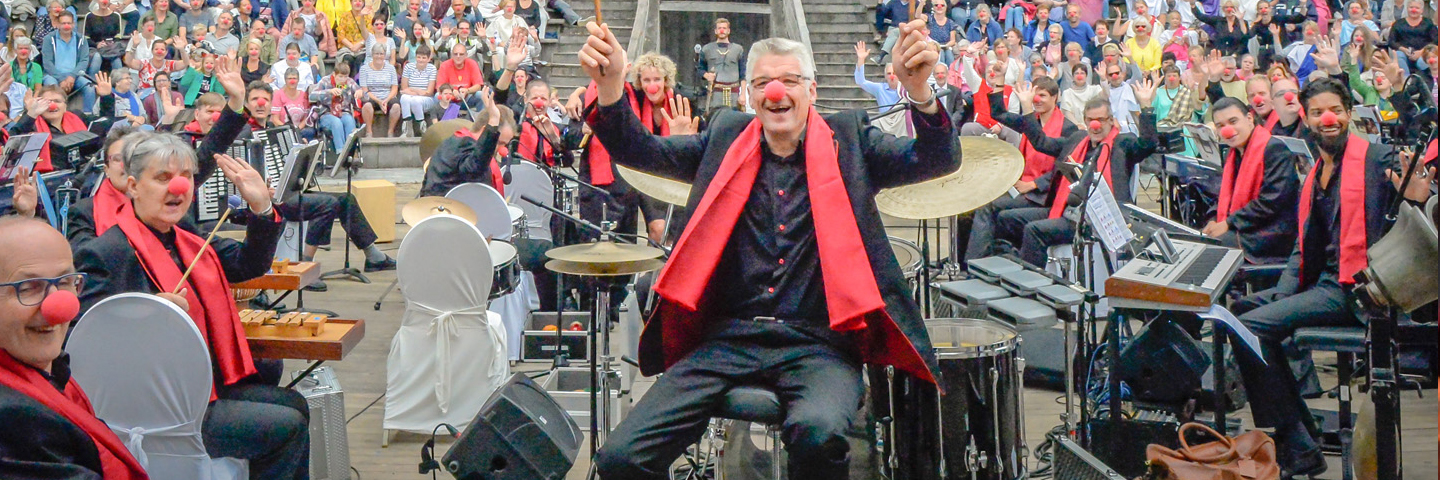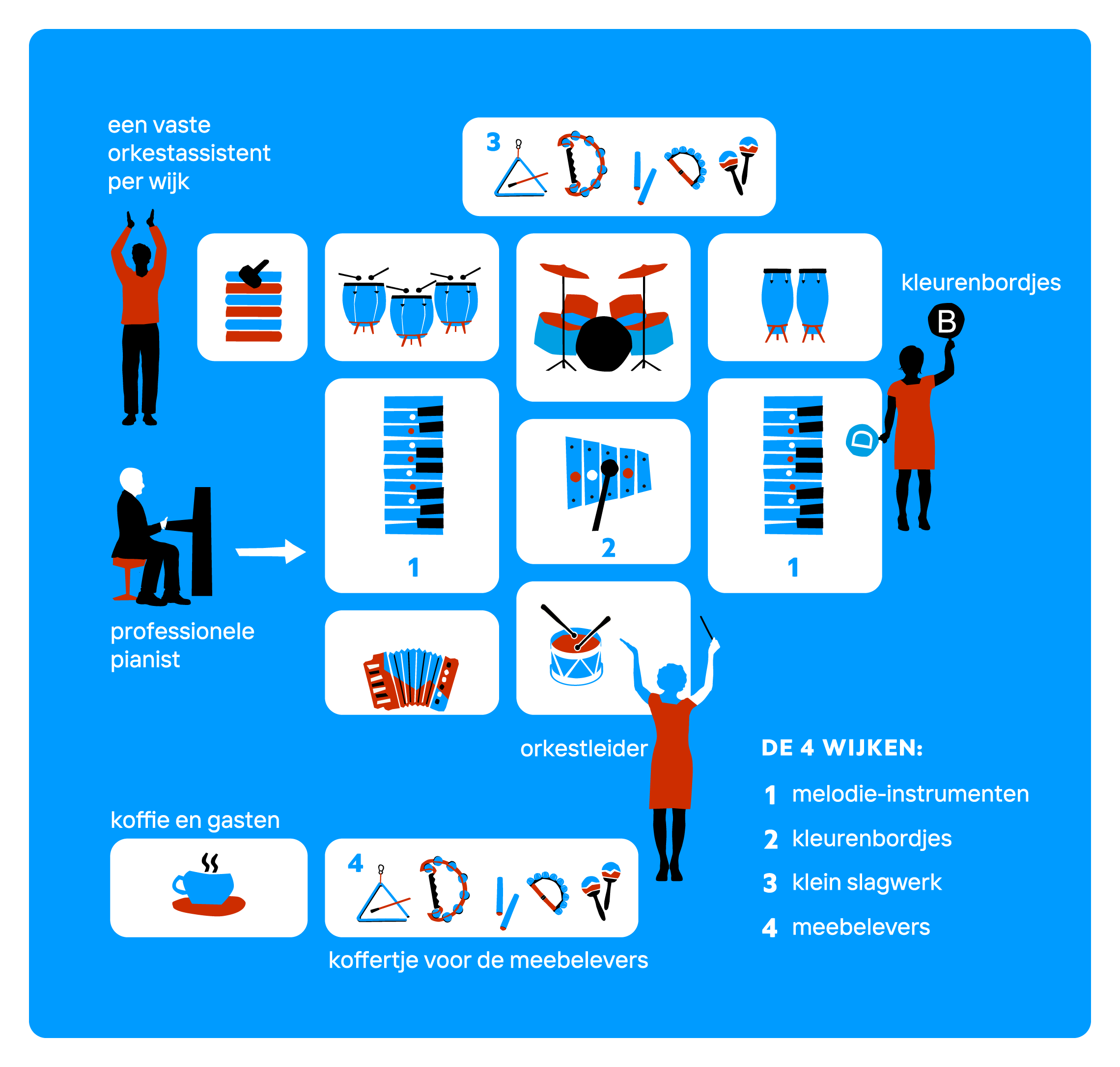In an orchestra or a band, you develop your musicality and social skills. Moreover, playing together is much more fun than on your own.
Starting a g-orchestra: music with a disability

7 starting tips for playing together
- Learning by participating. During a rehearsal you learn from each other. The steps are always: listening > participating > support through the colour notation.
- Own direction. At the Jostiband, each ‘district’ has one assistant (see map). At each level, band members must pay close attention: when do I have to come in and what is my part? Members of the orchestra also get tasks such as building up and cleaning up.
- Practice playing together. Melody instruments can play different voices. And percussion provides the rhythm. You practise harmonies and rhythm together as much as possible. You hear how your part sounds together with that of someone else This helps you remember it better than when practising separately.
- Predictable and strict. Alert, strict and clear accompaniment: this ensures that a rehearsal remains fun for everyone. Provide breaks at set times and rituals such as playing “Lang zal ze leven” on birthdays. Going to the toilet or playing with your mobile phone is not allowed during rehearsals. Jostiband orchestra leader Lyan Verburg: “We are strict, but that helps to maintain a good atmosphere.
- Taking account of each other. Sometimes you have to be quiet to listen. Or you have to wait to join in. Playing together also means working on social behaviour.
- Experiencers. Allow others to actively enjoy playing together. For example, with a bell or triangle. Set the bar high here too. People with serious disabilities can often learn to participate in the chorus only, for example.
- Work towards a goal. Whether it is a large concert or a small-scale performance, it is enormously motivating to share the music with the audience from time to time.
5 pitfalls for g-orchestras
Jostiband orchestra leader Lyan Verburg regularly receives emails or phone calls from beginning g-orchestras. She likes to share her knowledge and lessons learned.
- Time and money. A g-orchestra often costs much more time and effort than expected. Volunteers then drop out. Lyan Verburg: “People see us on TV and say: ‘I want to do that too’. But we have more than half a century of experience. Moreover, we have Ipse de Bruggen behind us. It’s almost impossible to do with volunteers alone. So make sure you have good support and an adequate budget.”
- No clear goal. “Is it about having fun making music? Or do you want to be on stage in six months’ time? In any case, make a plan. It often bleeds to death if you just rehearse and say: ‘OK guys, see you next time’.”
- The x-factor is missing. “We do a lot to give our orchestra members success experiences at performances. We think incredibly hard about whether something is worth listening to and watching. We go to great lengths to do that – think of things like the nose clippers we bring along to make sure all the members of the orchestra look well-groomed. And musically we just want to do something. Singing and wind instruments, for example, are often difficult in terms of mouth motor skills. If you perform regularly, as we do, then it is really important that you make it sound good and lift up the orchestra members”.
- Not enough own control. “Our approach is that orchestra members should do as much as possible themselves. There is nothing wrong with that, of course, but we are still finding out that clients can do more than we think. So try to incite and stimulate them.”
- Don’t start… “You shouldn’t underestimate what’s involved, but if you don’t start, you won’t get anywhere. What is very important is continuity. You just have to start. With this target group, it is really harder to explain if you stop after three months. That doesn’t mean you have to think big. Build a solid foundation and then keep working towards something. ”
G-orchestra: a story of experience
Harmonieorkest Vleuten (HOV) is an amateur association with 8 orchestras, including a g-orchestra since 2019. Christel Veenstra was involved in the start-up.
“We always asked ourselves: how do you get the orchestra members here and what does this target group need? Can we offer that? How much support do you need during the evening, for example? How do you make it predictable enough? Then, of course, recruitment and organisation took time.
Of course, you have to think about this target group beforehand, but in the end you just have to start. The orchestra leader chose five pieces and that’s how they started. We use the Jostiband’s sheet music, because it simply works. It’s so nice to see how enthusiastic people become about music.
We do a lot, unnoticed, to ensure that it remains fun for everyone. Some members of the orchestra have a special set of instructions. It can be unquiet sometimes, especially when the leaves are falling or the flowers are starting to bloom. That's why we don't want people to go to the toilet during rehearsal, for example. We are strict, but that helps to keep the atmosphere going.
Instruments of the Jostiband
Which instruments are suitable for a g-orchestra? Of course, at the Jostiband we are spoilt for choice. Even if you are just starting out, our list of instruments may inspire you.
The Jostiband has instruments for all levels. And: for all tastes. One likes to beat the drums. The other likes to play keyboard.
Moreover, we pay close attention to how the ensemble eventually sounds.
We do not have wind or string instruments. It is very difficult for people with a disability, often a motor disability, to play these instruments at the level that the orchestra is aiming for. So if necessary, the sounds come from the keyboards.
The basic instruments are:
Melody instruments
- Keyboards
- Electric pianos
- Accordions
- Xylophones
- Guitar
Rhythm instruments (percussion)
- Drum kits
- Small drum kits
- Timpani
- Glockenspiel
- Small percussion: tambourines, macaracas, bells, triangles, claves, rainsticks
For musical and visual dynamics, the orchestra also has all kinds of additional instruments that are used from time to time, such as djembés, cajons, and chimes. The eye-catcher in the front is the percussionist, who uses cabasas, claves, and a rattler as additional hand percussion instruments.
Rehearsing together
The article on Colour Music contains tips to help an individual musician get started. The same basic principle applies to ensembles: you learn to play by listening a lot and then joining in.
The Jostiband often needs a year to study a new song. It means above all: a lot of warming up, swinging along and slowly getting to know the song very well.
Harmonies
To make optimal use of the auditory memory and to train it, band members practice harmonies together as much as possible. You hear how your part sounds with that of someone else. This makes it easier to remember than when practising separately. The steps are also the same when learning the second voice on keyboard, for example:
- listening
- joining in
- support through the colour notation
When practising, it is no problem if everyone plays the melody first. Later, some of the keyboard players and accordionists will learn the second voice. Then there is the section that only plays the root tones. This is how harmonies are created. The keyboard sounds are also very important. The Jostiband often opts for string sounds, because the piano sound does not sound nice when 40 keyboards are being played simultaneously.
Small musical instruments from the ‘music case’
Musicians with severe multiple disabilities can also participate. They use small rhythm instruments such as a bell ring. The instruction is simple.
You learn by participating which instrument is needed when, for example: in the second chorus the tambourine, in the third the bells and nothing else.
The assistant indicates the starting and stopping moments and makes sure that the instruments are back on the table after use, so that no sounds continue to be heard.
Watch our play-along videos, choose a song, and click on ‘the music case’.
Jostiband repertoire and arrangements
The repertoire of the Jostiband is large: more than 100 songs, varying from religious songs such as “Heer uw licht” to “Viva la Vida” by Coldplay or “This is what it feels like” by Armin van Buuren. The orchestra actively plays around 20 to 25 songs.
Rehearsing a new song to concert level takes a year, so the choice is made carefully. Sometimes, several members of the orchestra come up with a song. In recent years, music that appeals to a young audience has been chosen deliberately. View the music books.
Arranging
Rehearsing a new song starts with the arranger, who sometimes listens to the song thirty times in order to analyse it completely. How dis it put together? What can you strip away? Even the melody line is often simplified. Only the regular pianist and one member of the orchestra play the complete part with two hands. About 20 members of the orchestra are quickly able to play the melody line. The rest follow.
Another must when arranging according to the Josti method: nobody is participating just for the sake of participating. So the arranger looks for logical, beautiful moments to insert small percussion, so that for example the ‘experiencers’ (EMB) can also be heard well.
When arranging and rehearsing, we always think ahead: how will it sound and how will it look? It's boring if you see everyone participating all the time. It has to be visually dynamic as well.
Jostibreaks: short musical activities
Making music with people with a disability gives energy. Have you already scheduled a Jostibreak?
A Jostibreak is a short musical activity. Think of a song on the guitar or playing with the music case full of small musical instruments.
Jostibreak with Dutch celebrities
On this site you will find 3 ready-made Jostibreaks. They are play-along videos with Maan, Guus Meeuwis, and Marco de Hollander. They are completely click and& go. Just watch and join in.
They are even more fun if you, as an assistant, help to get the most out of them. You can join in with various instruments with and without Colour Music. Check out the options and choose the best one for your activity.
